 |
| Manet, 1867 |
p 91 | The
Grand Prix de Paris was a horse race run at
Longchamp Racecourse (built 1857) in July. Still running.
p 92 | Mme Alphonse de Rothschild: (wiki). In 1857
Alphonse de Rothschild married a cousin,
Leonora "Laure" de Rothschild (1837–1911), the daughter of Lionel de Rothschild (1808–1879) of the English branch of the family. They had four children.
p 92 |
Baron Hirsch= Maurice de Hirsch de Gereuth (1831-96), Jewish banker & philanthropist.
p 92 | Charles-Ferdinand,
Duc de Berry (1778-1820). He is
reported by historians to have been temperamental, moody, selfish & extraordinarily ugly. For several years, he lived with (or married) an English woman named
Amy Brown, and they had two daughters. (Some claim there was an official marriage that was annulled by the Pope when the Bourbons returned to power. However, no documentation has been produced to support this.)
The Duc de Berry was assassinated in 1820; a deathbed act was to legitimize his two daughters by Amy Brown and they were adopted by his royal wife. Both daughters later received titles from the Duc the Berry's father--King Charles X.
Two of the Duc's other mistresses were: Eugénie Virginie Oreille (1795–1875):
had 2 sons: Charles Louis Auguste Oreille de Carrière (1815–58), who in turn fathered a son Charles (born in 1842), a lyric artist, married but without issue; and Ferdinand Oreille de Carrière (1820-76), who died unmarried.
With Marie Sophie de La Roche (1795–1883),
there were 2 sons: Ferdinand de La Roche (1817–1908) and Charles de La Roche (1820-1901).
None of these seem like Swann, or even like Swann's grandmother.
p 93 | "..where Monaldeschi was murdered...": (wiki) With the cession to the Papal States of Torre Alfina in 1664, the
Monaldeschi ceased to play a part in the politics of Central Italy, though the marchese Gian Rinaldo Monaldeschi was reputed to be the lover of
Christina of Sweden. When she discovered that Monaldeschi had betrayed her, she had him assassinated 10 November 1657, at Fontainebleau, where the she was staying. Her version is
here.
.png/320px-Pediment_(PSF).png) p 94 | panem et circenses ("bread and circuses"): a political strategy formed by Juvenal to govern/control the Roman masses.
p 94 | panem et circenses ("bread and circuses"): a political strategy formed by Juvenal to govern/control the Roman masses.
p 94 |
pediment: the triangular upper part of the front of a building in classical, neoclassical, and baroque style, typically above a portico of columns. May have relief sculptures.

p 94 | caryatids: Supporting columns sculpted in the form of draped female figures.
p 95 | Queen of Spain: did Proust mean Victoria
Eugenie of Battenberg (reigned 1906-31), a grand-daughter of Queen Victoria of England?
 p 115 | The Campo Santo, also known as Camposanto Monumentale ("monumental cemetery") is a 12th century edifice at the northern edge of the Cathedral Square in Pisa, Italy. "Campo Santo" can be literally translated as "holy field" (cemetery). There are celebrated frescos showing such funereal scenes
as The Triumph of Death and The Last Judgment. (Sturrock)
p 115 | The Campo Santo, also known as Camposanto Monumentale ("monumental cemetery") is a 12th century edifice at the northern edge of the Cathedral Square in Pisa, Italy. "Campo Santo" can be literally translated as "holy field" (cemetery). There are celebrated frescos showing such funereal scenes
as The Triumph of Death and The Last Judgment. (Sturrock)
.png/320px-Pediment_(PSF).png)










